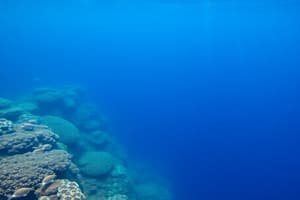Podcast
Questions and Answers
What is the primary difference between temperature and heat?
What is the primary difference between temperature and heat?
- Heat refers to the total energy of a substance, while temperature measures a substance's response to heat. (correct)
- Heat is the application of energy, while temperature is a constant value.
- Temperature can change more rapidly than heat.
- Temperature is measured in degrees, while heat is not.
Which of the following accurately describes water's specific heat capacity?
Which of the following accurately describes water's specific heat capacity?
- Water's specific heat is higher than that of rock.
- Water's specific heat is irrelevant for biological reactions.
- Water has a low specific heat, allowing quick temperature changes.
- Water resists changes in temperature due to its high specific heat. (correct)
Which property of water contributes to it being the universal solvent?
Which property of water contributes to it being the universal solvent?
- Its thermal conductivity.
- Its ability to form hydrogen bonds. (correct)
- Its viscosity and density.
- Its low freezing point.
What role does temperature stability play in the marine environment?
What role does temperature stability play in the marine environment?
What is one effect of ocean acidification on marine environments?
What is one effect of ocean acidification on marine environments?
What major limiting factor prevents some marine organisms from thriving in deeper waters?
What major limiting factor prevents some marine organisms from thriving in deeper waters?
Which organism accounts for the majority of marine primary productivity?
Which organism accounts for the majority of marine primary productivity?
What is one reason why oxygen can be a challenge for marine organisms?
What is one reason why oxygen can be a challenge for marine organisms?
What is a primary method by which marine organisms achieve gas exchange?
What is a primary method by which marine organisms achieve gas exchange?
Which of the following accurately describes the nutrient dynamics in the ocean?
Which of the following accurately describes the nutrient dynamics in the ocean?
What initiates rapid phytoplankton blooms in certain ocean zones?
What initiates rapid phytoplankton blooms in certain ocean zones?
How does the efficiency of marine primary producers compare to terrestrial producers?
How does the efficiency of marine primary producers compare to terrestrial producers?
What effect does human activity have on marine environments?
What effect does human activity have on marine environments?
What is the typical salinity of ocean water?
What is the typical salinity of ocean water?
How does warmer water affect the concentration of dissolved gases?
How does warmer water affect the concentration of dissolved gases?
What is the primary reason for the ocean acting as a carbon sink?
What is the primary reason for the ocean acting as a carbon sink?
Where is the oxygen minimum zone typically located?
Where is the oxygen minimum zone typically located?
What effect does increasing human activities have on carbon dioxide levels in the ocean?
What effect does increasing human activities have on carbon dioxide levels in the ocean?
At what pH range is seawater typically found?
At what pH range is seawater typically found?
What phenomenon does the presence of a pycnocline indicate?
What phenomenon does the presence of a pycnocline indicate?
Why does warm water have a unique heat-density relationship compared to other waters?
Why does warm water have a unique heat-density relationship compared to other waters?
Flashcards
Temperature vs. Heat
Temperature vs. Heat
Temperature measures how hot or cold something is, while heat is the energy transferred due to a temperature difference.
Water's Heat Capacity
Water's Heat Capacity
Water has a high heat capacity, meaning it takes a lot of heat energy to change its temperature. This makes water very stable and resistant to temperature fluctuations.
Thermal Inertia
Thermal Inertia
The tendency of a substance to resist changes in temperature, due to its high heat capacity. Water has high thermal inertia.
Water's Specific Heat
Water's Specific Heat
Signup and view all the flashcards
Seawater's Chemical Makeup
Seawater's Chemical Makeup
Signup and view all the flashcards
Salinity
Salinity
Signup and view all the flashcards
Typical Salinity
Typical Salinity
Signup and view all the flashcards
Salinity and Temperature
Salinity and Temperature
Signup and view all the flashcards
Ocean Stratification
Ocean Stratification
Signup and view all the flashcards
Pycnocline
Pycnocline
Signup and view all the flashcards
Dissolved Gases
Dissolved Gases
Signup and view all the flashcards
Ocean Acidification
Ocean Acidification
Signup and view all the flashcards
Oxygen Minimum Zone
Oxygen Minimum Zone
Signup and view all the flashcards
Oxygen in Water
Oxygen in Water
Signup and view all the flashcards
Gas Exchange in Marine Organisms
Gas Exchange in Marine Organisms
Signup and view all the flashcards
Primary Productivity in the Ocean
Primary Productivity in the Ocean
Signup and view all the flashcards
Light Limitation in the Ocean
Light Limitation in the Ocean
Signup and view all the flashcards
Nutrient Limitation in the Ocean
Nutrient Limitation in the Ocean
Signup and view all the flashcards
Chlorophyll-a as a Proxy
Chlorophyll-a as a Proxy
Signup and view all the flashcards
Upwelling and Productivity
Upwelling and Productivity
Signup and view all the flashcards
Phytoplankton's Importance
Phytoplankton's Importance
Signup and view all the flashcards
Study Notes
Oceanography 1 (Physical Environment and Productivity)
- Oceanography studies the physical and chemical properties of the ocean, including waves, tides, currents, and the environment's impact on marine life.
- It's strongly connected to biology and meteorology.
- The physical environment is a major driver of patterns in marine life, impacting factors like temperature, chemistry, light intensity, nutrients, and currents.
- Similarly, the biological environment plays a part.
- Examples of factors within the biological environment: predators, competitors, mutualisms, and diseases.
- The physical marine environment is often defined by temperature stability which is influenced by water's high specific heat.
- Water resists large fluctuations in temperature.
- A high specific heat leads to stable conditions for chemical reactions in the water.
- Daily temperature fluctuations in the air and water are less than fluctuations over seasons.
- Daily temperature variations in air (31°C-28°C) and on rocks (62°C-28°C) are relatively smaller in comparison to seasonal changes in air (36°C - -2°C) and water (30°C-17°C).
- Water has differing temperatures across the globe.
Chemical Properties
- Water acts as a universal solvent, dissolving various solids and gases.
- Salinity is the total concentration of dissolved substances in seawater, typically ~35 ppt (~3.5% dissolved substances).
- Warmer water dissolves more solids, thus higher salinity.
- Temperature strongly affects the amount of dissolved gases, and colder water dissolves more gases.
- Gases such as carbon dioxide (CO2) are crucial for marine life, as well as oxygen (O2).
Oxygen & Carbon Dioxide
- Oxygen and carbon dioxide levels in the ocean are not at equilibrium as dictated by chemistry.
- The ocean's depth affects the concentrations of dissolved gases.
- Oxygen levels are comparatively lower at depth compared to the surface.
- The reverse is true for CO2 at depth.
- The oxygen minimum zone occurs at depths between 200 and 1000 meters, which is associated with the rapid decrease in oxygen concentration and increase in CO2
- This is often connected to respiration and less productivity with depth, which are related to photosynthesis and the organisms living there.
- The ocean acts as a significant carbon sink (60 times more CO2), absorbing carbon dioxide from the atmosphere.
Water Density and Stratification
- Water's density is affected by temperature and salinity.
- A unique characteristic of water is that its density peaks at approximately 4°C (39.2°F).
- Water density is inversely related to temperature in most cases.
- Regions with a high density often have colder temperatures.
- Water stratification is caused by the differences in temperature and salinity, creating layers (surface zone, thermocline, pycnocline, deep zone).
Primary Productivity
- The ocean's productivity in creating oxygen matches terrestrial production but is much less dense.
- Phytoplankton, mostly, are the key marine primary producers.
- They capture light energy and convert it to organic matter.
- Limiting factors for productivity include light extinction (depth) and nutrient availability.
- Light extinction occurs quickly in water, so primary producers are restricted to surface regions.
- Nutrients are taken up rapidly by photosynthetic organisms, making their concentration hard to measure.
Upwelling
- Upwelling is a significant factor in productivity. It brings nutrient-rich water to the surface.
- Upwelling helps create nutrient-rich areas, leading to rapid phytoplankton blooms.
Pelagic Food Chains
- The ocean's primary producers, like phytoplankton, form the base.
- Humans utilize the organisms in the ocean's food chains, making the productivity of phytoplankton crucial for human existence.
Summary (Oceanography)
- Physical and chemical properties define the nature of marine life.
- These properties fluctuate by region and time (season, depth).
- Increasing human activities are affecting ocean conditions.
- Primary productivity is critical for sustaining human existence.
Studying That Suits You
Use AI to generate personalized quizzes and flashcards to suit your learning preferences.



